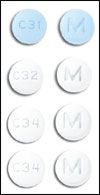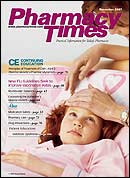Publication
Article
Pharmacy Times
PRODUCT profiles
Author(s):
Carvedilol Regular-release Tablets

Alpha- and beta-blocking drugs areused in the treatment of hypertension,and when 1 drug can combine the receptorblockade, it should be expected toenhance therapeutic outcomes. Carvedilol,a nonselective beta-blocker withselective alpha-1 blocking actions,appears to offer better results thanagents possessing only 1 variety ofreceptor-blocking activity. Carvedilol isavailable in 3.125-, 6.25-, 12.5-, and 25-mg tablet strengths from Apotex Inc,Caraco Pharmaceutical Laboratories, andMylan Laboratories.
The beneficial actions for beta-blockersin congestive heart failure are basedon theoretical action, suggesting adecrease of sympathetic outflow at thecardiac level or an alteration in reninrelease. The additional effect of alpha-1blockade with carvedilol results in generalperipheral arterial and venous dilation,with the effects on standing blood pressurebeing the most pronounced.
In general, beta-blockers are indicated for the treatment of hypertension,angina, and heart failure.Although carvedilol can be used asmonotherapy, it is usually employed inconjunction with other drug managementoptions (digoxin, thiazides, angiotensin-converting enzyme [ACE] inhibitors)to increase patient survival andreduce the frequency of hospitalization.
The nonselectivity of the beta-blockingeffect of carvedilol means that bronchialasthma is a specific contraindication toits use, with deaths reported followingeven a single dose. It also is not recommendedin the presence of hepaticimpairment or among the elderly.
The additive hypoglycemic effectsassociated with beta-blockers generallyrequire additional care among diabeticpatients.

Dosing for hypertension starts at 6.25mg twice daily, with an upper limit of 25mg twice daily. For congestive heart failure,the dose is 3.125 mg twice daily,gradually titrating to response or to amaximum of 6.25 mg twice daily. Oraldosing is little affected by food. In polytherapy,however, carvedilol should beadministered 2 hours prior to an ACEinhibitor to reduce orthostatic hypotensionand other symptoms of general vasodilation.In addition, cessation of therapyshould be done gradually to preventrebound pressor effects.
Among patients hospitalized with congestiveheart failure or left ventricular cardiacdysfunction, dischargeuse of drugs withbeta-blocking effects hasshown a significant reductionin mortality.
Verapamil Extended-release Capsules (PM)

Extended-release verapamil(PM) is available in capsule form in100-, 200-, and 300-mg strengths fromMylan Laboratories. Indications for verapamilinclude the management ofPrinzmetal-variant, unstable, or chronicstable angina; hypertension; and to controlventricular rates at rest or with concurrentatrial fibrillation. It also is used toprevent the recurrence of paroxysmalsupraventricular tachycardia.
The effect of calcium channel blockerssuch as verapamil on cardiac conductioncan create serious adverse effects, andwhile the frequency is under 2% overall,they can range from asymptomatic firstdegreeatrioventricular block to seriousthird-degree block. Other adverse effectsfrom oral administration are seen in over6% of users, requiring a reduction indose. The severity of the side effects increaseswith concurrent use of betablockersor digoxin. In some cases, thenegative inotropic effects associatedwith verapamil can actually cause congestiveheart failure or pulmonary edema.The most common complaint frompatients regarding verapamil is constipation.

To treat hypertension with the extended-release capsule version of verapamil(PM), the usual adult dose is 200 mg atbedtime, with upward titration to a maximumof 400 mg at bedtime. Blood pressuremeasurements should be carefullymonitored.
The strong protein binding affinity for verapamilimplies that other drugs (eg, aspirin, phenytoin, warfarin)could disrupt stabilized blood levels.Dosing with beta-blockers and digoxinrequires careful monitoring to preventtoxicity and excessive hypotension.
Verapamil requires a reduced doseamong the elderly and should be usedcautiously with hepatic or renal impairment.Verapamil also may both prolongthe effect of alcohol and increase bloodconcentrations by up to 17%. Althoughverapamil should be taken with food,grapefruit poses a potential interactionand should be avoided during this therapy.







